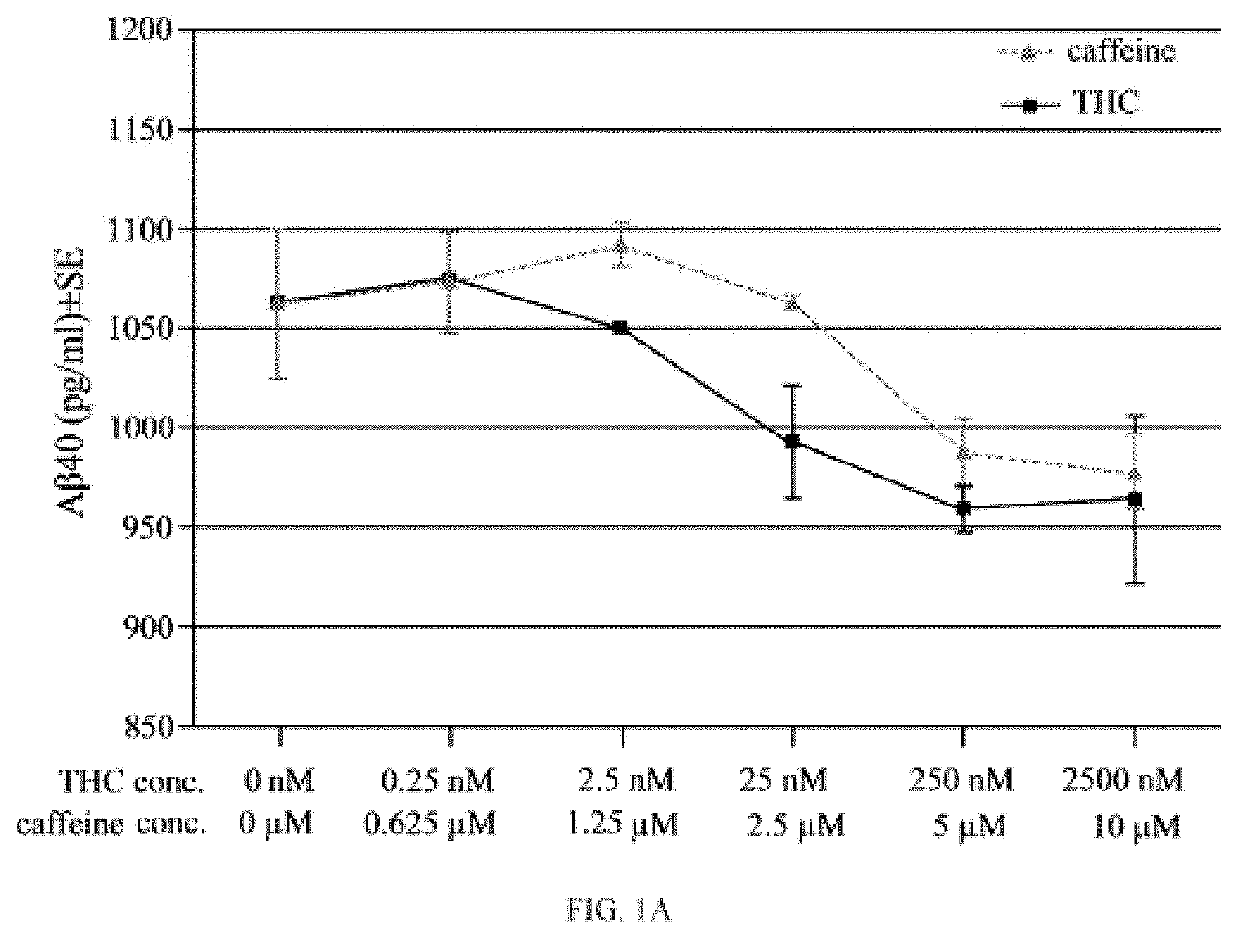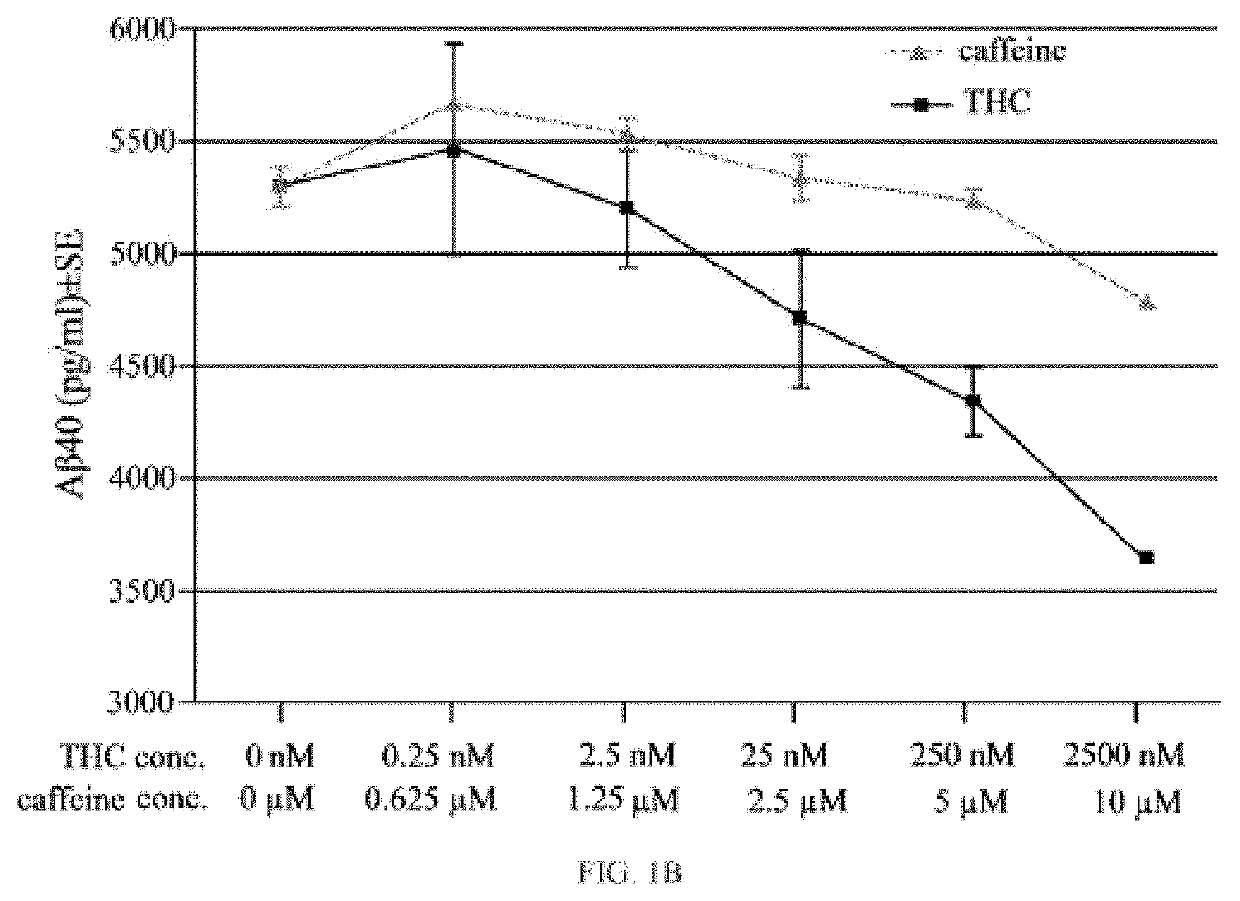Ultra-low dose thc as a potential therapeutic and prophylactic agent for alzheimer's disease
a technology of alzheimer's disease and low dose, applied in the field of alzheimer's disease treatment, can solve the problems of a lack of effective treatment, a burden on caregivers, and the health care system, and no effective treatment developed to cure or delay the progression
- Summary
- Abstract
- Description
- Claims
- Application Information
AI Technical Summary
Benefits of technology
Problems solved by technology
Method used
Image
Examples
example 1
t of THC on Aβ40 and AβPP Expression, and the Effect of the Combination of THC and Melatonin on AβPP Expression in N2a / AbPswe Cells
[0106]Studies prior to 2015 reveal that THC and melatonin reduce the secretion of APP and Aβ expression levels. We set out some of the studies prior to 2015 and one study in 2015 to support the statement that THC and melatonin reduce the secretion of APP and Aβ expression levels. For example:
[0107]A 1997 study on PC12 cells showed that melatonin reduced the secretion of soluble APP. (Song and Lahari, Melatonin alters the metabolism of the beta-amyloid precursor protein in the neuroendocrine cell line PC12. J Molecular Neuroscience 1997: 75-92.
[0108]A 1998 study PC12 cells showed that melatonin prevents Aβ aggregation. (Pappolia M, Inhibition of Alzheimer's beta fibrillogenesis by melatonin, Jour. Of Biological Chemistry 1998: 7185-8).
[0109]A 2001 study on neuroblastoma cells showed that administration of melatonin resulted in a reduction of Aβ levels. (O...
example 2
t of THC and the Effect of the Combination of THC and Melatonin on Mitochondrial Function in N2a / AβPPswe Cells
[0124]Our findings show an un-expected result, at ultra-low doses THC works differently from a high dosage of THC, including at the levels recommended by the FDA for Dronabinol. At ultra-low doses THC enhances mitochondrial function, rather than diminishing mitochondrial function. As explained before, the recommended FDA adult human dose for Dronabinol is between 5 milligrams to 20 milligrams. The highest dose of THC considered in our study is almost 4 times lower than the lowest FDA recommended dose.
[0125]Several studies have shown that high dose of THC decreases mitochondrial function whereas we show that ultra-low-dose of THC enhances mitochondrial function (FIG. 14A and FIG. 14B). Examples of early studies that show that cannabinoids can decrease oxidative metabolism of isolated mitochondria. The influence of delta9-tetrahydrocannabinol, cannabinol and cannabidiol on tis...
example 3
t Effect of THC on Aβ Aggregation, One Pathological Marker of AD
[0133]Additional hallmarks of AD pathology involve formation of Aβ aggregation.
[0134]In 2006 Eubanks and et al, demonstrated that THC competitively inhibits the enzyme acetylcholinesterase (AChE) as well as prevents AChE induced amyloid beta-peptide (Abeta) aggregation. The concentration used was 50 Eubanks's study indicate that 50 micro molar corresponds to 15.7 micro grams / ml. Therefore Eubanks dosing is in the range that causes psychological impairments. (Eubanks L M, et. al. A molecular link between the active component of marijuana and Alzheimer's disease pathology. Mol Pharm. 2006 November-December (36): 773-7.)
[0135]FIG. 3A shows that at ultra-low dose of THC, between 0.25 nM to 250 nM at the cell level, lowers Aβ aggregation. Further, at these low concentrations, which are about 20,000 times less than that used by Eubanks, there are no psychological impairments or significantly reduced psychological impairments ...
PUM
 Login to View More
Login to View More Abstract
Description
Claims
Application Information
 Login to View More
Login to View More - R&D Engineer
- R&D Manager
- IP Professional
- Industry Leading Data Capabilities
- Powerful AI technology
- Patent DNA Extraction
Browse by: Latest US Patents, China's latest patents, Technical Efficacy Thesaurus, Application Domain, Technology Topic, Popular Technical Reports.
© 2024 PatSnap. All rights reserved.Legal|Privacy policy|Modern Slavery Act Transparency Statement|Sitemap|About US| Contact US: help@patsnap.com










